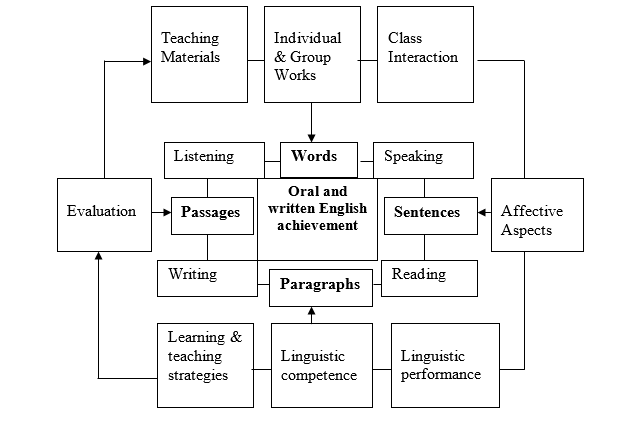Investigating learning outcome based on a model of English teaching of Indonesian elementary students
DOI:
https://doi.org/10.21070/jees.v6i2.1110Keywords:
Teaching model, research and development, English achievement, elementary school studentsAbstract
This research aim of this study is to develop a model of teaching English for Indonesian elementary students. This developmental research consisted of five key procedures: analysis of need, model design, development, implementation, and evaluation. In the model development, two treatments were conducted to test the model. In the evaluation, a pre-test and post-test were administered to see the effectiveness of the model and the instructional materials in enhancing the English achievement of the students. The subject consisted of three school headmasters, three English teachers, and the fourth graders of three elementary schools in Makassar city. The teaching model consisting of four main stages: pre-activity, presentation, practice, and evaluation considers three main aspect: the language skill, language performance, and pedagogic aspects. The result indicates that the English teaching model is successful in enhancing the students’ achievement in English and learning interest. In its form, the teaching model is flexible; it helps teacher write instructional materials, write lesson plans, teach, and analyze the teaching and learning process. The standards in thefieldsupportthe model and the teaching of students.
HIGHLIGHTS:
- The procedure of analysing and implementation model of teaching should become the requirement of the instructional material development in enhancing the achievement of the students.
- The main activity in teaching and learning process become the main contribution to have a wonderful result to encounter the bias or the difficulties during the learning process.
- Designing appropriate instructional materials as entry requirements to answer the learning outcome of teaching English for elementary students.
Downloads
References
Agustiani, I. W. D. (2017). the Correlation Between Students Reading Attitude and Their Reading Comprehension Achievement. English Community Journal. https://doi.org/10.32502/ecj.v1i2.764
Baş, G., & Bas, G. (2012). Reading Attitudes of High School Students : An Analysis from Different Variables. International Journal on New Trends in Education and Their Implications, 3(2), 47–58. Retrieve from http://ijonte.org/FileUpload/ks63207/File/04.bas.pdf.
Ellis, H., & Van Aart, J. (2013). Key influencers of international student satisfaction in Europe 2013. Study Portals.
Hackathorn, J., Solomon, E. D., Blankmeyer, K. L., Tennial, R. E., & Garczynski, A. M. (2011). Learning by Doing: An Empirical Study of Active Teaching Techniques. The Journal of Effective Teaching, 11(2), 40–54.
Hamra, A. (2010). Developing a Model of Teaching Reading Comprehension for Efl Students. TEFLIN Journal, 21(1), 27–40. https://doi.org/10.15639/teflinjournal.v21i1/27-40
Hamra, A., & Syatriana, E. (2012). A model of reading teaching for university EFL students: Need analysis and model design. English Language Teaching. https://doi.org/10.5539/elt.v5n10p1
Işman, A. (2011). Instructional design in education: New model. Turkish Online Journal of Educational Technology, 10(1), 136–142.
Kirkpatrick, A. (2016). The journal of Asia TEFL. Journal of Asia TEFL, 13(1), i–iii. https://doi.org/10.18823/asiatefl.2016.13.1.1.i
Mantasiah, R., Yusri, & Jufri. (2019). The role of bilingualism in increasing children’s cognitive ability at primary school. Asian EFL Journal, 23(62), 42–55.
Melendy, G. A. (2008). Motivating Writers: The Power of Choice. Asian EFL Journal, 10(3), 187–198. Retrieved from http://search.proquest.com/docview/85671973?accountid=14548%5Cnhttp://metadata.lib.hku.hk/hku?url_ver=Z39.88-2004&rft_val_fmt=info:ofi/fmt:kev:mtx:journal&genre=article&sid=ProQ:ProQ:llba&atitle=Motivating+Writers:+The+Power+of+Choice&title=Asian+EFL+Jou
Noortyani, R. (2018). An Exploratory Study on Students’ Reading Interest Development through, 9(2), 108–117.
Nunn, R., & Toms, C. (2009). The Asian ESP Journal. The Asian ESP Journal, 5(2), 1–120.
OECD. (2013). PISA 2018 Results. Combined Executive Summaries. Journal of Chemical Information and Modeling, 53(9), 1689–1699. https://doi.org/10.1017/CBO9781107415324.004
Rashidi, N., & Kehtarfard, R. (2014). A needs analysis approach to the evaluation of Iranian third-grade high school English textbook. SAGE Open. https://doi.org/10.1177/2158244014551709
Shah-Wundenberg, M., Wyse, D., & Chaplain, R. (2013). Parents helping their children learn to read: The effectiveness of paired reading and hearing reading in a developing country context. Journal of Early Childhood Literacy, 13(4), 471–500. https://doi.org/10.1177/1468798412438067
Sönmez, H. (2019). An Examination of Needs Analysis Research in the Language Education Process. International Journal of Education and Literacy Studies, 7(1), 8. https://doi.org/10.7575/aiac.ijels.v.7n.1p.8
Sukirmiyadi. (2018). Teaching English to Young Learners Through Indonesian - Translated Songs. Journal of Physics: Conference Series, 953(1), 193–200. https://doi.org/10.1088/1742-6596/953/1/012236
Syatriana, E. (2016). Implementing a Design Model in Teaching Writing through Reflection Strategy for Indonesian EFL Students. Asian EFL Journal, 2.
Syatriana, Eny, & Akib, E. (2019). The effect of mapping instructional materials on EFL learners with different types of materials. International Journal of Humanities and Innovation (IJHI), 2(2), 20–24. https://doi.org/10.33750/ijhi.v2i2.37
Tasneen, W. (2010). Literary texts in the language classroom: A study of teachers’ and students’ views at international schools in Bangkok. Asian EFL Journal, 12(4), 173–187.
Training, T., & Tidar, U. (2019). The Implementation of Curriculum 2013 Revision on Lesson Plans Made by
English Teachers of SMAN 2 Magelang in School Year 2018 / 2019, 17–23.
https://www.kemdikbud.go.id/main/blog/2016/12/peringkatdan-capaian-pisa-indonesia-mengalami-peningkatan, retrieved 30 March 2020.
https://www.kompasiana.com/frncscnvt/5c1542ec677ffb3b533d6105/pisa-dan-literasi-indonesia, retrieved 30 March 2020

Published
How to Cite
Issue
Section
License
Copyright (c) 2021 Eny Syatriana, Akib Erwin

This work is licensed under a Creative Commons Attribution 4.0 International License.







